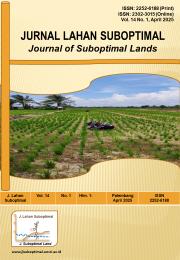Pests and diseases of horticultural crops in Tanjung Seteko Village Indralaya District, Ogan Ilir Regency, South Sumatra
DOI:
https://doi.org/10.36706/jlso.14.1.2025.662Keywords:
Cucumber mosaic virus, Diaphania indica, fusarium wilt, Valanga sp., vegetationAbstract
Cultivation of horticultural crops is often faced with the problem of plant pests, namely pests and plant diseases which cause plant productivity to decrease. In controlling pests and diseases, farmers often use synthetic pesticides, but farmers use pesticides that do not comply with regulations. The research aimed to identify species of pests and diseases in horticultural crops and farmers' in Tanjung Seteko Village, Indralaya District, Ogan Ilir Regency, South Sumatra in controlling pests and diseases of horticultural crops. This research method used purposive sampling and direct observation in the field. The farmers who were interviewed were farmers who grew horticultural crops. The results of this research found that vegetation around plants influences the diversity of pests and diseases. There were 8 pest species found with the highest attack rate of 17.56%, namely Diaphania indica attacks and the lowest attack intensity was Valanga sp. 0.19%. There were 8 types of diseases found with the highest attack rate being 41.11% (Cucumber mosaic virus) and the lowest at 0.56% (fusarium wilt). Pest and disease control with the application of synthetic pesticides by farmers was in a good category. The scoring of farmer’s respondent statements in Tanjung Seteko Village was obtained with a score range of 28-41. The scoring results show that farmer’s behavior in using pesticides is in the good category.
References
Aditya, R., Pranatawijaya, V. H., & Putra, P. B. A. A. (2021). Designing an activity monitoring application using the prototype method. Journal of Information Technology and Computer Science, 1(1), 47–57.
Alzarliani, W. O. Al, Purnamasari, W. Od. D., & Muzuna. (2020). How to control plant disturbing organisms (opt) of vegetable crops in Ngkaring-Karing Village. Jurnal Pengabdian Kepada Masyarakat Membangun Negeri, 4(2), 188–195.
Aridhayandi, M. R., & Naufal, M. R. (2021). Counselling on the wise use of pesticides for the realisation of sustainable agriculture (in the farmers group of Sukalarang Village) Sukabum District. J-Abdi Jurnal Pengabdian Kepada Masyarakat, 1(5), 789–794.
Arsi, A., Sukma, A. T., SHK, S., Hamidson, H., Irsan, C., Suwandi, S., Pujiastuti, Y., Nurhayati, N., Umayah, A., & Gunawan, B. (2022). Application of appropriate pesticide use in controlling vegetable plant disrupting organisms in Tanjung Baru Village, Indralaya Utara. SEMAR (Jurnal Ilmu Pengetahuan, Teknologi, dan Seni Bagi Masyarakat), 11(1), 108. https://doi.org/10.20961/semar.v11i1.56894
Basna, M., Koneri, R., & Papu, A. (2017). Distribution and diversity of soil insects in forest park. Jurnal MIPA, 6(1), 36–42.
Benu, M. M. M., Tae, A. S. J. A., & Mukkun, L. (2020). Impact insecticides of residues on the diversity of soil fungi on mustard greens land. J. II. Tan. Lingkungan, 22(2), 80–88. https://doi.org/10.29244/jitl.22.2.80-88
Handoko, J., Fauzana, H., & Sutikno, A. (2017). Population and attack intensity of horned beetle (oryctes rhinoceros linn.) on immature oil palm (Elaeis guineensis Jacq.) plants. Jurnal Online Mahasiswa Fakultas Pertanian Universitas Riau, 4(1), 944‒945.
Hertanto, D., Fadwiwati, A. Y., Hipi, A., & Anasiru, R. (2019). Farmers' perception of jarwo transplanter rice planting technology in supporting food self-sufficiency. AGROVITAL: Jurnal Ilmu Pertanian, 4(2), 38. http://dx.doi.org/10.35329/agrovital.v4i2.494
I, A. T. P., Rahayu, S., & Oktarianti, S. (2022). Pest control without chemical pesticides in vegetable cultivation in Kotabaru Village, Pontianak. Jurnal Abdi Masyarakat Indonesia (JAMSI), 2(3), 991–998. https://doi.org/10.54082/jamsi.355
Lenaini, I. (2021). Purposive and snowball sampling techniques. Jurnal Kajian, Penelitian & Pengembangan Pendidikan Sejarah, 6(1), 33–39. https://doi.org/10.31764/historis.v6i1.4075
Manyamsari, I. (2014). Farmer characteristics and their relationship with the competence of narrow land farmers (Case: Sinar Sari Village, Dramaga Sub-District, Bogor District, West Java). Jurnal Agrisep Unsyiah, 15(2), 58–74.
Marbun, D. N. V. D., Satmoko, S., & Gayatri, S. (2019). The role of agricultural extension officers in the development of horticultural crop farmer groups in Siborongborong District, Tapanuli Regency. Jurnal Ekonomi Pertanian dan Agribisnis, 3(3), 537–546.
Muliasari, A. R. T. (2020). Incidence of major pests and diseases of sugarcane (Saccharum officinarum L.) at PT PG Rajiwali II Jati Majalengka. Sains Terapan, 10(1), 40–52.
Nazimah, N., Nilahayati, N., Safrizal, S., & Fachrurrazi, S. (2022). Community empowerment in baloy village, blang mangat Sub-District in the application of biofertilisers for horticultural crop cultivation. Jurnal Vokasi, 6(1), 40. http://dx.doi.org/10.30811/vokasi.v6i1.2923
Oka, I. G. A. D. S., Darmawan, D. P., & N. W. S. A. (2016). The success of the sustainable food home area programme (KRPL) for women farmers groups in Gianyar Regency. Jurnal Manajemen Agribisnis, 4(2), 133–146.
Pohan, S. (2014). Utilisation of plant extracts as natural pesticides (biopesticides) in insect pest control (Selvia Dewi Pohan). JURNAL Pengabdian Kepada Masyarakat, 20(75), 94–99.
Rahmasari, D. A., & Muhammad. (2020). Factors associated with farmers' subjective health complaints from pesticide use in Gondosuli, Central Java. Jurnal Nasional Ilmu Kesehatan (JNIK), 3, 14–28.
Rismayadi, B. (2016). Factors affecting employee productivity (case study at cv mitra bersama lestari in 2016). Jurnal Manajemen & Bisnis Kreatif, 1(1), 1–16.
Sarvina, Y. (2019). Climate change impacts and adaptation strategies for fruit and vegetable crops in the tropics. Jurnal Penelitian dan Pengembangan Pertanian, 38(2), 65. http://dx.10.21082/jp3.v38n2.2019.p65-76
Soesanto, L., Mugiastuti, E., & Manan, A. (2021). Application test of secondary metabolites of weed pathogenic fungi against narrow leaf weeds. In Proceedings Seminar Nasional dan Call for Papers, (pp.132–141).
Sulainsyah, I., Ekawati, F., Hariandi, D., Obel, O., Ramadhan, N., & Martinsyah, R. H. (2019). Making vegetable pesticides as a pioneer in the harapan baru farmer group in Alahan Panjang Village, Solok Regency. Jurnal Hilirisasi IPTEKS, 2(3.b), 254–263.
Supriatna, A. H., Haneda, N. F., & Wahyudi, I. (2017). Population distribution, damage percentage, and damage level due to boktor in sengon: Effect of age, diameter, and tree height. Jurnal Silvikultur Tropika, 8(2), 79–87. https://doi.org/10.29244/j-siltrop.8.2.79-87
Suparman, Arsi, Gunawan, B., Umayah, A., Pujiastuti, Y., & Hamidson, H. (2023). The evaluation of implementation of integrated pest and disease control by farmers of food and holticultural corps in Banyuasin and Ogan Komering Ulu Timur. Sainmatika: Jurnal Ilmiah Matematika Dan Ilmu Pengetahuan Alam, 20(1), 63–71. https://doi.org/10.31851/sainmatika.v20i1.11144
Syarifuddin, & Hilda, L. (2023). Utilisation of plants as biological pesticides to control pests and diseases of chilli plants in support of sustainable agriculture. Jurnal Pengabdian Masyarakat, 2(3), 22–34.
Tanaya, I. G. L. P., Rosmilawati, R., & Hidayati, A. (2020). Production risk analysis of vegetable farming in North Lombok Regency. Jurnal Agrimansion, 21(2), 69–81. https://doi.org/10.29303/agrimansion.v21i2.383
Tulak, T., Situru, R. S., & Batatta, Z. (2023). Utilization of palm vinegar as a natural herbicide to eradicate weeds. Jurnal Pengabdian Kepada Masyarakat, 7(4), 998–1003. https://doi.org/10.31849/dinamisia.v7i4.15239
Wahyudi, K. D. (2018). Strategic policies for agricultural businesses in the context of increasing production. Majalah Ilmiah “DIAN ILMU,” 11(2), 78–91. https://doi.org/10.37849/midi.v11i2.15
Downloads
Published
How to Cite
Issue
Section
License
Copyright (c) 2025 Arsi Arsi, Tika Rahmawati, Amirah Salsabila, Fuji Anugrah, Mira Andani, Fitri Ani, Rintan Sartika Rahmadhonna, Muhammad Arifudin

This work is licensed under a Creative Commons Attribution-NonCommercial-ShareAlike 4.0 International License.













